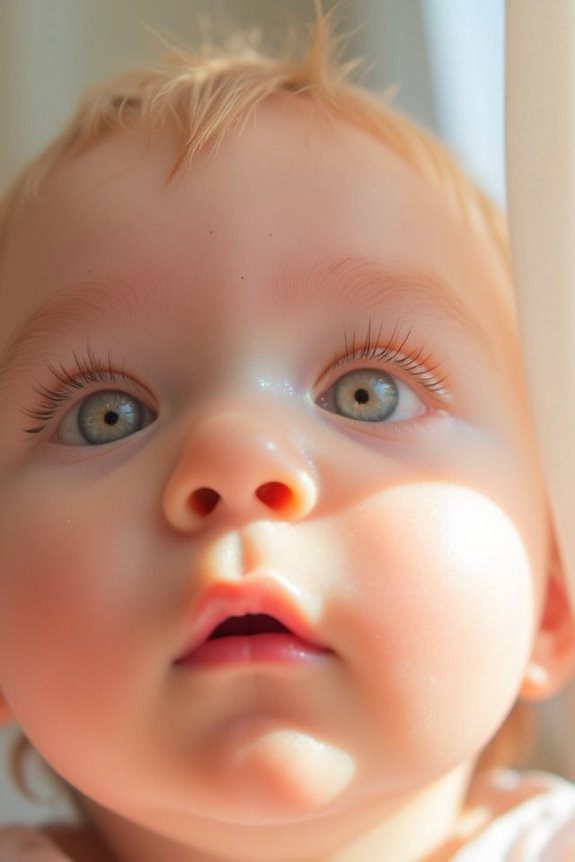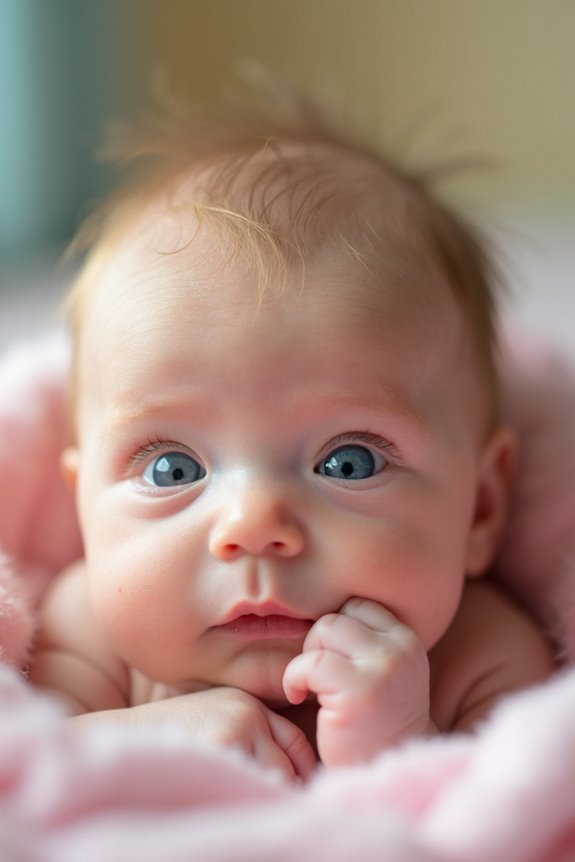Babies’ eyes can change color within the first few years, mainly due to melanin production in the iris. Initially, most newborns have low melanin levels, often resulting in blue or gray eyes. As they grow, this can shift significantly from 0-3 months and stabilize by around 9 months. Subtle changes may continue until age 3. Understanding this process can help us appreciate the unique beauty of our little ones. Let’s explore more about these fascinating changes.
Key Takeaways
- Babies typically have blue or gray eyes at birth due to low melanin levels in the iris.
- Significant eye color changes usually occur between 3 to 6 months as melanin production increases.
- Most babies settle into their permanent eye color by around 9 months old.
- Subtle changes in eye color may continue into early childhood, up to 3 years.
- Eye color changes are primarily genetic, influenced by over 150 genes, not environmental factors.
Understanding Eye Color Determination
When we talk about how babies’ eyes change color, it’s important to understand the complex factors that determine eye color in the first place. Eye color primarily results from genetic inheritance, influenced by several genes. The OCA2 gene plays a significant role, affecting melanin production, while the HERC2 gene helps determine whether a baby has blue eyes.
Melanin distribution in the iris is crucial—more eumelanin leads to brown eyes, while lower levels contribute to blue or green eyes. Other genes, like TYR and TYRP1, also impact melanin production. As melanin increases in your baby’s first year, you might notice their eye color shifting, making this journey of discovery even more exciting.
The Physiology Behind Eye Color Change
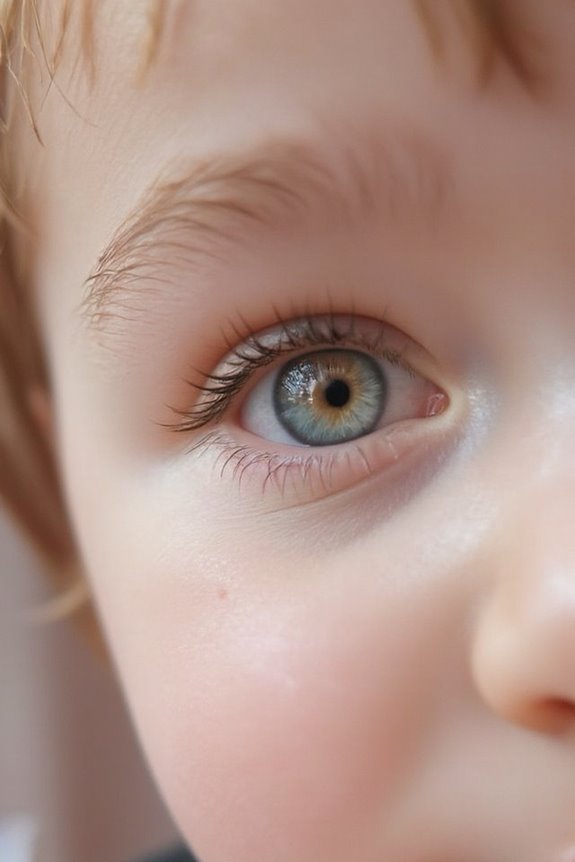
As we explore the physiology behind eye color change, it’s fascinating to note how our bodies develop in ways that influence our appearance. Eye color is largely determined by melanin production in the iris, which is responsible for the darkness of the eye. At birth, low melanin levels often result in blue or gray eyes.
- As babies grow, melanocytes become active, increasing melanin levels.
- The iris structure, particularly the stroma, scatters light and plays a key role in eye color.
These changes typically occur within the first few months, and by around nine months, most children have their permanent eye color, though some subtle shifts may continue until age three. Understanding this process helps us appreciate our little ones’ unique traits.
Timing of Eye Color Changes
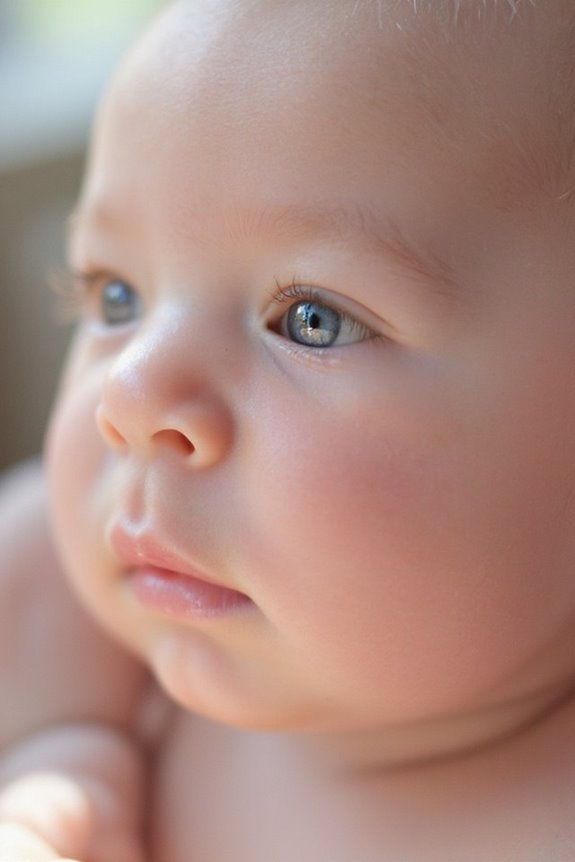
Understanding how our little ones’ eyes change color is a fascinating journey that many new parents experience. Typically, our babies are born with blue, gray, or slate-colored eyes due to minimal melanin.
- 0-3 Months: Changes begin as melanin starts to accumulate.
- 3-6 Months: This is when we often see dramatic shifts in eye color.
- 6-9 Months: Most babies settle into their final eye color during this stage.
- Up to 3 Years: Subtle changes can continue into early childhood.
It’s important to remember that while we may have initial expectations based on their birth eye color, these changes are part of normal baby development. The unpredictability adds to the wonder of watching our little ones grow!
Factors Influencing Eye Color
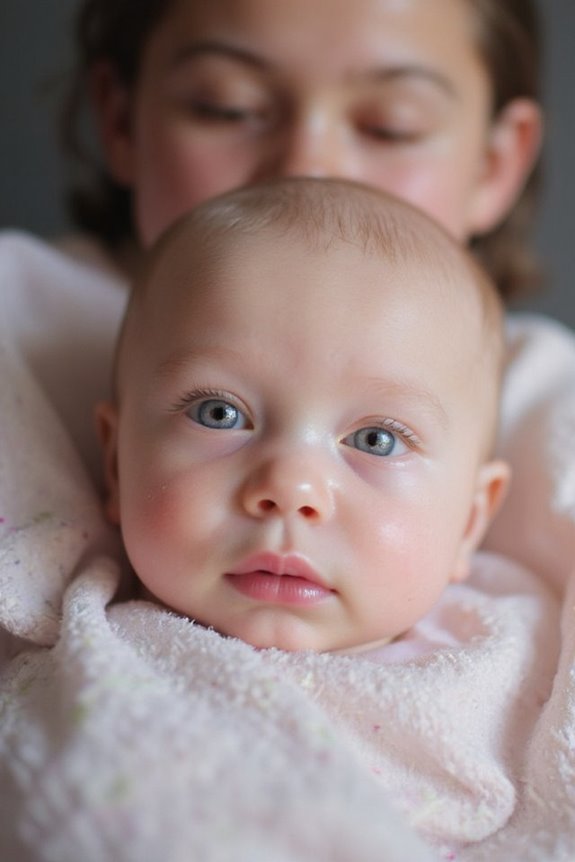
Eye color, a captivating aspect of our little ones’ appearance, is influenced by a blend of genetic and environmental factors that shape their unique traits. The complexity of eye color arises from:
- Genetic Diversity: Over 150 genes contribute to eye color, with OCA2 and HERC2 playing pivotal roles in determining shades like brown and blue.
- Melanin Levels: The amount of melanin in the iris is crucial; more melanin means darker eyes, while less leads to lighter hues.
- Environmental Impact: Although environmental factors don’t change eye color, they can influence genetic expression over time.
Predicting Final Eye Color

Predicting a baby’s final eye color can feel like a guessing game, especially since so many factors are at play. Eye color genetics is complex, involving multiple genes and inheritance patterns from both parents. Here’s what to consider:
- Dominant vs. Recessive: Brown is dominant, while blue and green are recessive. If both parents have brown eyes, there’s a 75% chance their baby will too.
- Statistical Tools: Eye color calculators can estimate probabilities, but they simplify genetic models and may not capture all nuances.
- Genetic Combinations: Each parent contributes genes that interact in unpredictable ways, making exact predictions tricky.
While we can guess based on parental eye colors, remember that certainty isn’t possible without specific genetic information.
Common Misconceptions About Eye Color Changes
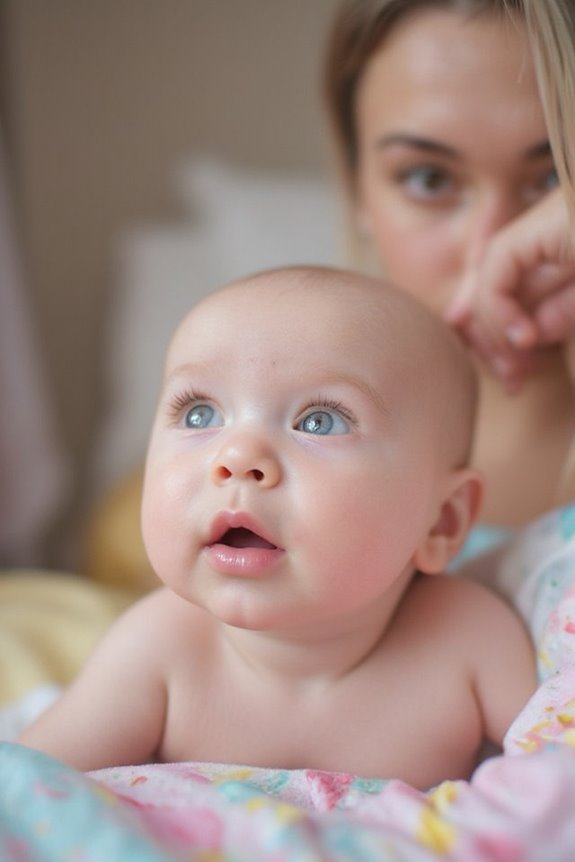
Many parents find themselves puzzled by the changes in their baby’s eye color, especially after learning about the various factors that influence it. Let’s clear up some myths debunked in the world of eye color trivia:
- Most significant eye color changes happen between 3 to 6 months, but some may last until a year.
- Changes can be subtle and gradual, often hard to notice.
- Eye color isn’t influenced by light exposure or hygiene; it’s primarily genetic.
- By 9 months, many babies’ eye colors stabilize, but minor shifts can still occur.
Understanding these facts helps us embrace our little ones’ evolving beauty while appreciating that eye color changes don’t follow a strict timeline.
Genetic Influence on Eye Color

While we might think of eye color as a straightforward trait, the reality is that it’s shaped by a complex interplay of genetics. Eye color isn’t determined by a single gene; over 150 genes contribute to this beautiful spectrum.
- Key players include the OCA2 and HERC2 genes, which can create unexpected outcomes, like brown-eyed children from blue-eyed parents.
- Genetic variations and interactions among these genes influence melanin production, leading to diverse shades.
Because of this complexity, predicting your child’s eye color isn’t as simple as it seems. Each combination of genes can lead to unique results, showcasing the fascinating diversity of human features. Understanding these genetic intricacies helps us appreciate the uniqueness of our little ones even more.
The Fascinating Journey of Eye Color Development
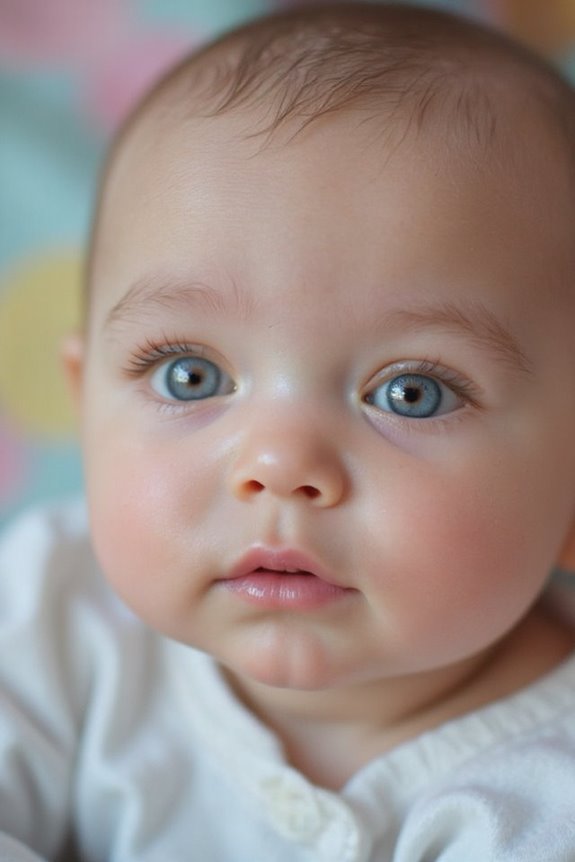
As we embark on the journey of understanding how babies’ eye colors develop, it’s important to recognize that this process unfolds in stages, much like the rest of their growth.
- Initial Changes: Most significant eye color shifts happen between 3 and 6 months.
- Permanent Color: By 6 to 9 months, many babies reveal their permanent eye color, though some subtle changes can persist until age 3.
- Melanin’s Role: As melanin accumulates, we might see transformations, like blue changing to brown or gray shifting to green.
While each child’s pace varies, observing these changes can be a delightful part of baby development. So, let’s enjoy this captivating journey, knowing that our little ones’ eyes will continue to tell their unique stories!
Frequently Asked Questions
Can Eye Color Changes Be Influenced by Diet or Nutrition?
We’ve often wondered if diet can influence eye pigmentation. While nutrition plays a vital role in eye health, it doesn’t directly change color. Let’s focus on nourishing ourselves for healthy eyes instead of chasing myths.
Do Certain Eye Colors Have Better Vision Than Others?
We’ve often wondered if eye color affects vision. While genetic factors play a role in our visual health, research shows that eye color doesn’t significantly determine our overall visual acuity or clarity.
Can Eye Color Change Due to Health Issues?
Imagine those vibrant hues shifting; eye color can indeed change due to health issues. We’ve seen how genetic factors intertwine with health implications, reminding us to cherish each glance and monitor our well-being closely.
How Do Lighting Conditions Affect Perceived Eye Color?
We understand that lighting effects can significantly impact color perception. Different light intensities and spectrums can make our eyes appear lighter or darker, creating a beautiful interplay between our environment and how we see each other.
Is There a Connection Between Eye Color and Personality Traits?
We’ve often wondered about the connection between eye color and personality traits. While genetic influence shapes both, studies show no strong link exists. Instead, perceptions are shaped by culture and personal biases we all hold.

